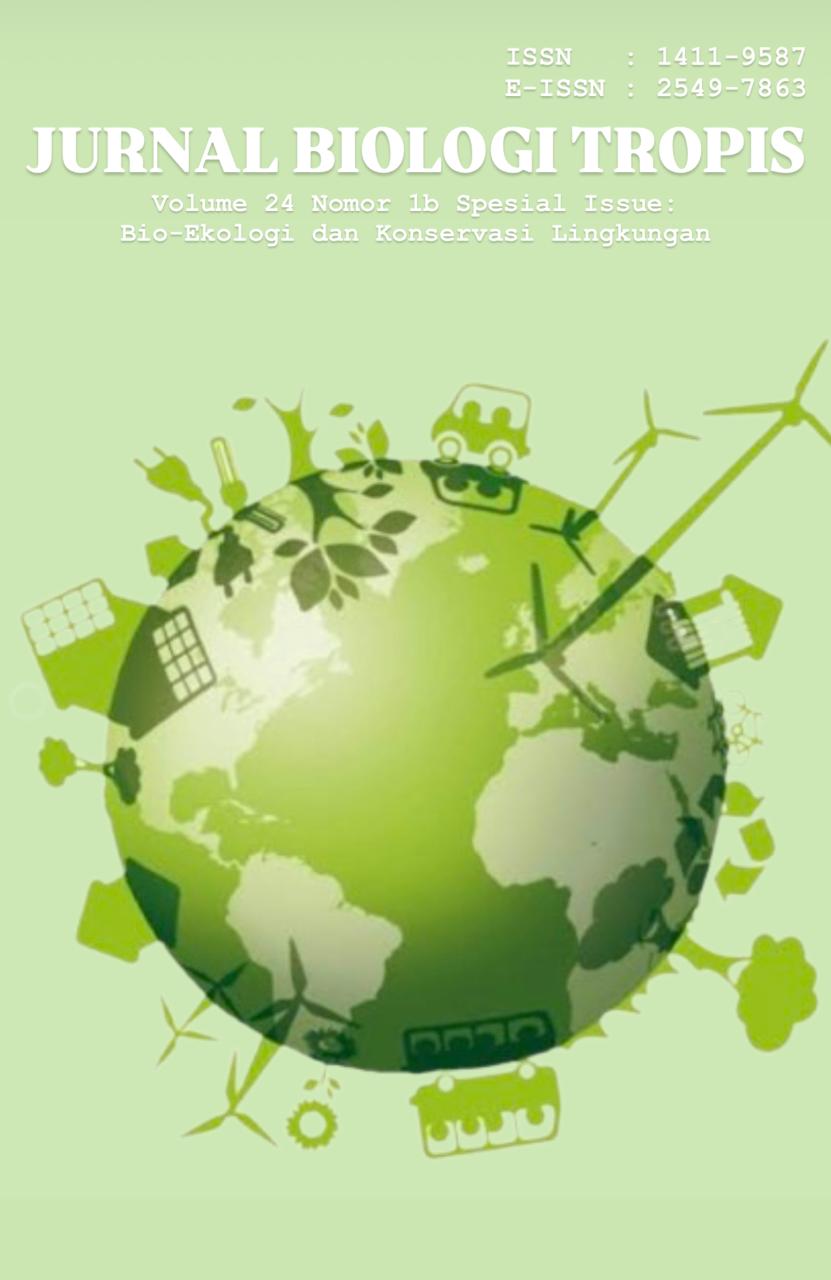Tree Shading Effect on Diversity and Competitions of Understorey Cover in IPB Campus Dramaga
Authors
Ilma Rahmawati , Dwika Bramasta , Pramesty Wulan Ramadhanty , Slamet Arif SusantoDOI:
10.29303/jbt.v24i2b.8107Published:
2024-12-17Issue:
Vol. 24 No. 2b (2024): Special IssueKeywords:
Asystasia gangetica, Axonopus compressus, Phytolacca americana, shade tolerant.Articles
Downloads
How to Cite
Downloads
Metrics
Abstract
Knowledge of competition at the plant community level is useful as a basis for studying competition aspects in a broader scope. One of the simplest things is understory competition due to differences in tree canopy cover. The purpose of this study was to describe the role of shade trees on competition and understory community structure. A total of 6 plots measuring 1 m × 1 m were made under stands of Ficus calosa, Ficus benjamina, and Terminalia catappa trees (Location 1 and Location 2), while 3 other plots of the same size were made under stands of Hevea brasiliensis trees (Location 3). Structure, composition and diversity were studied using vegetation analysis techniques. The results showed that Locations 1 and 2 were dominated by Phytolacca americana and Asystasia gangetica, while Location 3 was dominated by Axonopus compressus and Asystasia gangetica. Further analysis showed outlier data from the three locations indicated an abundant number of individuals of Phytolacca americana and Asystasia gangetica, and Axonopus compressus. All of these dominant species are invasive. Regression analysis shows that the projection of increasing canopy cover causes an increase in the density of certain species, but not significantly (P >0.05). The higher the dominance index, the smaller the species diversity value. Therefore, it can be concluded that a dominant species is usually competitive and can change the distribution structure and diversity of understory plants under different tree canopies.
References
Ainiyah, R., Fathurraman, A., Wibisono, M., Aji, F. R., & Yusuf, D. (2017). Pengaruh jenis tegakan terhadap komposisi dan keanekaragaman tumbuhan bawah di Hutan Sapen Kecamatan Prigen Kabupaten Pasuruan. Agromix, 8(1): 50-63. https://doi.org/10.35891/agx.v8i1.564.
Armesto, J. J., Cheplick, G. P., & McDonnell, M. J. (1983). Observations on the reproductive biology of Phytolacca americana (Phytolaccaceae). Bulletin of the Torrey Botanical Club. 380–383. https://doi.org/10.2307/2996194.
Balandier, P., Mårell, A., Prévosto, B., & Vincenot, L. (2022). Tamm review: Forest understorey and overstorey interactions: So much more than just light interception by trees. Forest Ecology and Management, 526. 120584. https://doi.org/10.1016/j.foreco.2022.120584.
Biswas, S. M., Chakraborty, N., & Patra, S. R. (2017). A new phenol glycoside from root exudates of Peperomia pellucida L. HBK. and its role. Annals of Tropical Research. 39(2): 13-24. https://www.cabidigitallibrary.org/doi/full/10.5555/20193027939.
Bricca, A., Bonari, G., Padullés Cubino, J., & Cutini, M. (2023). Effect of forest structure and management on the functional diversity and composition of understorey plant communities. Applied Vegetation Science, 26(1): e12710. https://doi.org/10.1111/avsc.12710.
Curtis, J. T., & Cottam, G. (1956). Plant Ecology Work Book. Laboratory Field Reference Manual. Burgess Publishing Co: Minnisota.
de las Heras, P., Medina-Villar, S., Pérez-Corona, M. E., & Vázquez-de-Aldana, B. R. (2020). Leaf litter age regulates the effect of native and exotic tree species on understory herbaceous vegetation of riparian forests. Basic and Applied Ecology, 48: 11-25. https://doi.org/10.1016/j.baae.2020.07.005.
Dwiati, M., Rochmatino., & Maharning, A. R. (2003). Persistensi dan toksisitas herbisida Reflex serta kemampuan tumbuh kembali biji Synedrella nodiflora dilihat dari kandungan bahan aktif fomesafen dalam tanah dan tubuh gulma. In Prosiding Himpunan Ilmu Gulma 26(2): 47-54.
Ewel, J. J., & Mazzarino, M. J. (2008). Competition from below for light and nutrients shifts productivity among tropical species. Proceedings of the National Academy of Sciences. 105(48): 18836-18841. https://doi.org/10.1073/pnas.0807216105.
Fauzi, T., Sarjito, A., Tini, E. W., & Khusna, R. N. (2023). Variabilitas gulma di bawah tegakan pohon karet (Hevea brasiliensis) di perkebunan rakyat Desa Pageralang, Kecamatan Kemranjen, Banyumas. Biofarm: Jurnal Ilmiah Pertanian, 19(1): 151-159.
Fu, X., Yang, F., Wang, J., Di, Y., Dai, X., Zhang, X., & Wang, H. (2015). Understory vegetation leads to changes in soil acidity and in microbial communities 27 years after reforestation. Science of the Total Environment, 502: 280-286. https://doi.org/10.1016/j.scitotenv.2014.09.018.
Hierro, J. L., & Callaway, R. M. (2003). Allelopathy and exotic plant invasion. Plant and Soil. 256(1): 29–39. https://doi.org/10.1023/A:1026208327014.
Holmgren, M., Scheffer, M., & Huston, M. A. (1997). The interplay of facilitation and competition in plant communities. Ecology. 78(7): 1966–1975. https://doi.org/10.1890/0012-9658(1997)078[1966:TIOFAC]2.0.CO;2.
Kim, H.-R., & You, Y.-H. (2010). Effects of elevated CO2 concentration and increased temperature on leaf related-physiological responses of Phytolacca insularis (native species) and Phytolacca americana (invasive species). Journal of Ecology and Environment. 33(3): 195–204. https://doi.org/10.5141/JEFB.2010.33.3.195.
Kurnia, A., Hasyim, M. A., & Prasetya, K. N. (2022). Struktur komunitas tumbuhan bawah di zona pemanfaatan Blok Ireng-Ireng Taman Nasional Bromo Tengger Semeru (TNBTS). RADIKULA: Jurnal Ilmu Pertanian, 1(2): 78-85. https://doi.org/10.33379/radikula.v1i2.1918.
Kusmana, C. (2017). Metode Survey dan Interpretasi Data Vegetasi. PT Penerbit IPB Press.
Li, N., Yang, W., Fang, S., Li, X., Liu, Z., Leng, X., & An, S. (2017). Dispersal of invasive Phytolacca americana seeds by birds in an urban garden in China. Integrative Zoology. 12(1): 26–31. https://doi.org/10.1111/1749-4877.12214.
Meyer, J., & Lavergne, C. (2004). Beautés fatales: Acanthaceae species as invasive alien plants on tropical Indo‐Pacific Islands. Diversity and Distributions. 10(5‐6): 333-347. https://doi.org/10.1111/j.1366-9516.2004.00094.x.
Moktan, S., & Das, A. P. (2013). Diversity and distribution of invasive alien plants along the altitudinal gradient in Darjiling Himalaya, India. Pleione. 7(2): 305–313.
Murali, S., Dhananjaya, P., Reddy, G. N., & Vinayaka, T. (2013). Study of insect pollinator’s diversity in Asystasia gangetica (L.). Environment and Ecology. 31: 804-806. https://www.cabidigitallibrary.org/doi/full/10.5555/20133255913.
Purnomo, D. W., Usmadi, D., & Hadiah, J. T. (2018). Dampak keterbukaan tajuk terhadap kelimpahan tumbuhan bawah pada tegakan Pinus oocarpa Schiede dan Agathis alba (Lam) Foxw. Jurnal Ilmu Kehutanan. 12(1): 61-73. https://doi.org/10.22146/jik.34121.
Samarakoon, S. P., Wilson, J. R., & Shelton, H. M. (1990). Growth, morphology and nutritive quality of shaded Stenotaphrum secundatum, Axonopus compressus and Pennisetum clandestinum. The Journal of Agricultural Science. 114(2): 161-169. https://doi.org/10.1017/S0021859600072154.
Samedani, B., Juraimi, A. S., Anwar, M. P., Rafii, M. Y., Awadz, S. A. S., & Anuar, A. R. (2012). Competitive ability of some cover crop species against Asystasia gangetica and Pennisetum polystachion. Acta Agriculturae Scandinavica, Section B–Soil & Plant Science. 62(7): 571-582. https://doi.org/10.1080/09064710.2012.677855.
Samedani, B., Juraimi, A. S., Rafii, M. Y., Anuar, A. R., Sheikh Awadz, S. A., & Anwar, M. P. (2013). Allelopathic effects of litter Axonopus compressus against two weedy species and its persistence in soil. The Scientific World Journal. 2013: 1-10. https://doi.org/10.1155/2013/695404.
Setiayu, D. P., Wibowo, D. N., & Yani, E. (2020). Keanekaragaman tumbuhan bawah pada berbagai umur tegakan jati (Tectona grandis L.) di KPH Banyumas Timur. BioEksakta: Jurnal Ilmiah Biologi Unsoed, 2(1): 79-85. . https://doi.org/10.20884/1.bioe.2020.2.1.1856.
Shelford, V. E. (1931). Some concepts of bioecology. Ecology. 12: 455-467. https://doi.org/10.2307/1928991.
Smith, A. L., & Dyer, A. R. (2013). Exploring the mechanisms of allelopathic interaction in the invasive annual plant, Phyllanthus urinaria. Journal of the South Carolina Academy of Science. 11(2): 4. https://scholarcommons.sc.edu/jscas/vol11/iss2/4/.
Susanto, S. A., Budirianto, H. J., Maturbongs, A. C., & Putra, S. A. (2019). Potensi dan keragaman tumbuhan bawah non-kayu di lahan bera Womnowi Distrik Sidey Manokwari. Ulin: Jurnal Hutan Tropis. 3(1): 10-18. http://dx.doi.org/10.32522/ujht.v3i1.1878.
Susanto, S. A., Putri, D. M., Rahmawati, I., & Sanjaya, M. A. (2021). Keragaman permudaan pohon di area sumber air Blok Seda, Taman Nasional Gunung Ciremai. Jurnal Sumberdaya Hayati. 7(2): 62-70. https://doi.org/10.29244/jsdh.7.2.62-70.
Thakur, T. K. (2018). Diversity, composition and structure of understorey vegetation in the tropical forest of Achanakmaar Amarkantak Biosphere Reserve, India. Environmental Sustainability, 1(3): 279-293. https://doi.org/10.1007/s42398-018-00028-y.
Uddin, M. K., Juraimi, A. S., Ismail, M. R., Othman, R., & Rahim, A. A. (2011). Relative salinity tolerance of warm season turfgrass species. Journal of Environmental Biology. 32(3): 309-317. https://pubmed.ncbi.nlm.nih.gov/22167942/.
van Oijen, D., Feijen, M., Hommel, P., den Ouden, J., & de Waal, R. (2005). Effects of tree species composition on within‐forest distribution of understorey species. Applied Vegetation Science, 8(2), 155-166. https://doi.org/10.1111/j.1654-109X.2005.tb00641.x.
Yusra, Y., Hidayat, M., & Eriawati, E. (2018, April). Struktur komunitas tumbuhan herba di bawah tegakan Pinus (Pinus merkusii) di Tahura Pocut Meurah Intan. In Prosiding Seminar Nasional Biologi, Teknologi dan Kependidikan (Vol. 5, No. 1) pp. 172-179. https://jurnal.ar-raniry.ac.id/index.php/PBiotik/article/view/2129.
Zhao, H., Wei, Y., Wang, J., & Chai, T. (2019). Isolation and expression analysis of cadmium‐induced genes from Cd/Mn hyperaccumulator Phytolacca americana in response to high Cd exposure. Plant Biology. 21(1): 15-24. https://doi.org/10.1111/plb.12908
License
Copyright (c) 2024 Ilma Rahmawati, Dwika Bramasta, Pramesty Wulan Ramadhanty, Slamet Arif Susanto

This work is licensed under a Creative Commons Attribution 4.0 International License.

Jurnal Biologi Tropis is licensed under a Creative Commons Attribution 4.0 International License.
The copyright of the received article shall be assigned to the author as the owner of the paper. The intended copyright includes the right to publish the article in various forms (including reprints). The journal maintains the publishing rights to the published articles.
Authors are permitted to disseminate published articles by sharing the link/DOI of the article at the journal. Authors are allowed to use their articles for any legal purposes deemed necessary without written permission from the journal with an acknowledgment of initial publication to this journal.


























